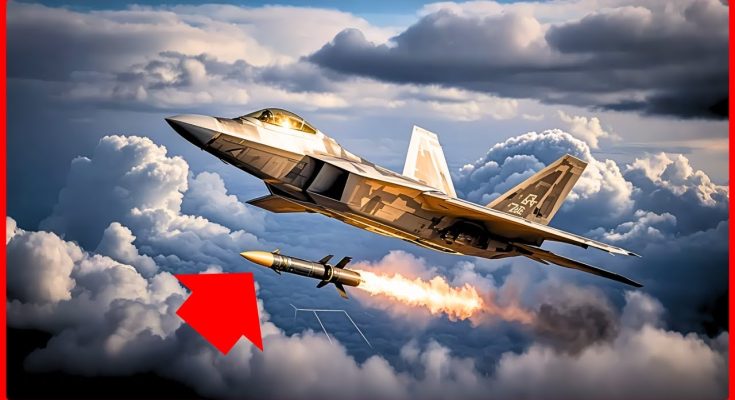In 2025, the United States Air Force (USAF) stunned the world with the aggressive upgrade of its iconic F-22 Raptor, an aircraft that has long been hailed as the pinnacle of air superiority and stealth technology. Originally introduced in 2005 at a cost of approximately $150 million per unit, the F-22 has been the foundation of America’s fighter fleet for nearly two decades. However, the latest $1.5 billion upgrade to the F-22, aimed at transforming it into a next-generation fighter, has left military analysts and adversaries alike astounded. This upgrade promises to extend the life of the F-22, enhance its combat capabilities, and maintain its dominance in the skies for decades to come.
Enhanced Stealth and Signature Reduction
The F-22 Raptor’s stealth capabilities have always been one of its most defining features, allowing it to operate in contested environments with minimal risk of detection. The aggressive upgrade improves on this foundation by introducing next-gen radar-absorbent materials and advanced coatings that further reduce the aircraft’s radar cross-section (RCS). These innovations make the F-22 even more difficult to track and engage, ensuring that it remains undetectable by enemy radar systems, even in complex, high-threat scenarios.
Additionally, the upgrade has included enhancements to the aircraft’s infrared signature—a critical factor in evading infrared sensors and heat-seeking missiles. With these modifications, the F-22 can now operate in environments where even the most advanced enemy tracking systems struggle to detect it, keeping the aircraft one step ahead of any threats.
Advanced Avionics and Sensor Fusion
The most significant aspect of the F-22’s $1.5 billion upgrade is the integration of cutting-edge avionics and sensor fusion technology. The F-22 has long been known for its exceptional situational awareness, but the new enhancements have taken this to an entirely new level. The next-gen radar system installed on the F-22 allows for long-range detection of airborne and ground-based threats, providing the pilot with real-time data on targets over vast distances.
Moreover, the sensor fusion capabilities of the F-22 have been significantly upgraded. The new systems integrate data from various sensors, including radar, electronic warfare systems, infrared sensors, and satellite communications. This data integration allows the pilot to see the battlefield in unprecedented detail, enabling quicker decision-making and more precise targeting. This enhanced situational awareness is critical for engaging targets at long ranges while maintaining air superiority over adversary aircraft.
Improved Weapons Systems
While the F-22 has always been known for its exceptional dogfighting capabilities, the new upgrades expand its versatility and lethality across multiple combat domains. The air-to-air missile system has been upgraded with new next-gen air-to-air missiles capable of engaging highly maneuverable and stealthy targets, making the F-22 even more lethal in aerial combat.
The F-22 can now carry a broader range of precision-guided munitions (PGMs) for air-to-ground strikes. This marks a departure from its original design, which focused primarily on air-to-air combat. The upgraded F-22 is now capable of engaging ground targets with laser-guided bombs, smart munitions, and highly accurate cruise missiles, giving it greater flexibility and versatility in combat situations. This makes the aircraft capable of performing a wide range of missions, from air dominance to close air support and precision strike.
Increased Engine Performance and Range
The F-22’s performance has always been legendary, with its supercruise capability allowing it to fly at supersonic speeds without afterburners. The upgrade improves engine efficiency and thrust, giving the F-22 an even greater operational range and fuel efficiency. This allows the aircraft to stay in the fight longer without the need for frequent refueling, increasing its flexibility and reach during missions.
Additionally, the upgraded engines contribute to the aircraft’s improved maneuverability and ability to sustain high-speed flight in both offensive and defensive maneuvers. This makes the F-22 a formidable opponent, capable of evading or engaging hostile aircraft with unmatched agility and speed.
AI and Autonomous Capabilities
One of the most groundbreaking aspects of the F-22’s upgrade is the integration of artificial intelligence (AI) and autonomous systems. The new AI systems assist in target identification, threat detection, and flight optimization, allowing the aircraft to process vast amounts of data and make informed decisions without overburdening the pilot. The AI also enhances the F-22’s autonomous flying capabilities, allowing the aircraft to operate with minimal pilot input in certain combat situations, improving safety and mission efficiency.
Furthermore, the F-22 is now equipped with next-gen electronic warfare (EW) systems powered by AI, which enables the aircraft to jam or deceive enemy radar and missile systems more effectively. These EW systems add an additional layer of protection, ensuring the aircraft can operate in highly contested environments without being neutralized by advanced anti-aircraft systems.
Global Impact
The $1.5 billion upgrade to the F-22 Raptor has sent shockwaves through the defense world. Adversaries like Russia and China, who have been developing advanced fighter jets of their own, must now reconsider their strategies in the face of a more powerful, more lethal F-22. The F-22’s enhanced stealth, sensor capabilities, and combat flexibility give the U.S. Air Force a decisive edge in both air superiority and precision strike missions.
Moreover, the integration of AI, autonomous systems, and advanced weapons ensures that the F-22 will remain a critical component of the U.S. Air Force’s fighter fleet for decades. With these enhancements, the F-22 is positioned to maintain its dominance in the skies, ensuring that the U.S. military remains prepared to counter any threat.
Conclusion
The $1.5 billion upgrade of America’s F-22 Raptor has redefined the aircraft’s capabilities and reaffirmed its position as the premier air superiority fighter in the world. With improved stealth, advanced avionics, enhanced weapons systems, and AI integration, the F-22 has evolved from a legendary fighter into a highly advanced, multi-role platform capable of tackling the most sophisticated threats. The world now knows that the F-22, while already a symbol of military aviation excellence, is only getting better, leaving adversaries to scramble to match its new capabilities.



